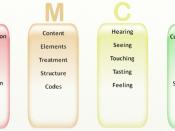The word communication is taken from the word communicate which is also taken from the word commune. The word commune means to share ideas, feelings, according to the Grolier's dictionary. Communication is the process of imparting or interchanging of thoughts and opinions by speech, writing or signs. There are several types and kinds of communication. Some types of communication are: mass communication, group communication, individual, public, interpersonal and intrapersonal communication, corporate communication.
Kinds of involves how the communication process is carried out, this can also be considered the setting of communication. The kinds of communication are formal, informal, grapevine and bypass communication.
Kinds of communication may either be formal or informal communication.
Types of communication.
Formal communication includes a planned format. Formal communication is prepared thoroughly by the sender or agents of the sender. It is planned in familiar mediums known or expected to be known by the receiver or receivers.
Formal communication may be in the form of written messages such as letters, memorandum, reports, etc. the sender ensures the message is properly formatted for effectiveness. Prepared speeches for meeting purposes or in rare cases, entertainment, is done to ensure effectiveness and optimum persuasion of the receiver or receivers involved. In formal written communication, since the reader can always go back and re-read the message, repetition usually is not desirable in written communication, except occasionally to emphasize a point. Writers are expected to exert enough effort to arrive at original ways of making a point instead of relying on clichés. Formal writing has a logical pattern that stays on track without digressing. Writers revise their message carefully so that sentences read smoothly. Individual sentences are well structured, and the sentences flow together. Each word counts, and, instead relying on casual transitions like "well â¦," the writer finds...



Good
Good information although it switches between writing styles.
1 out of 1 people found this comment useful.